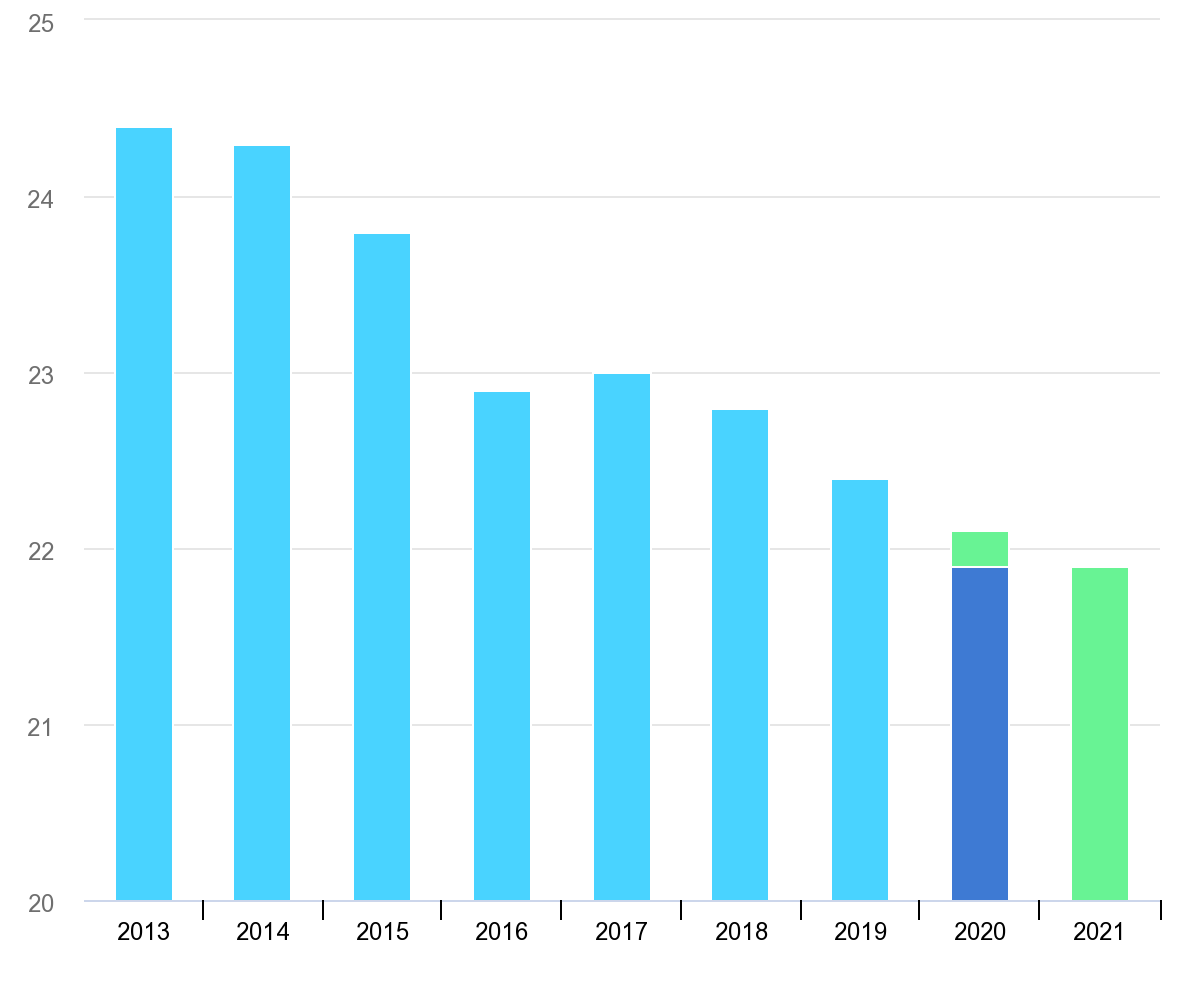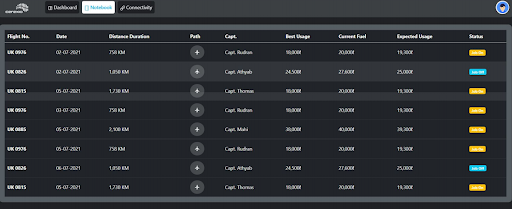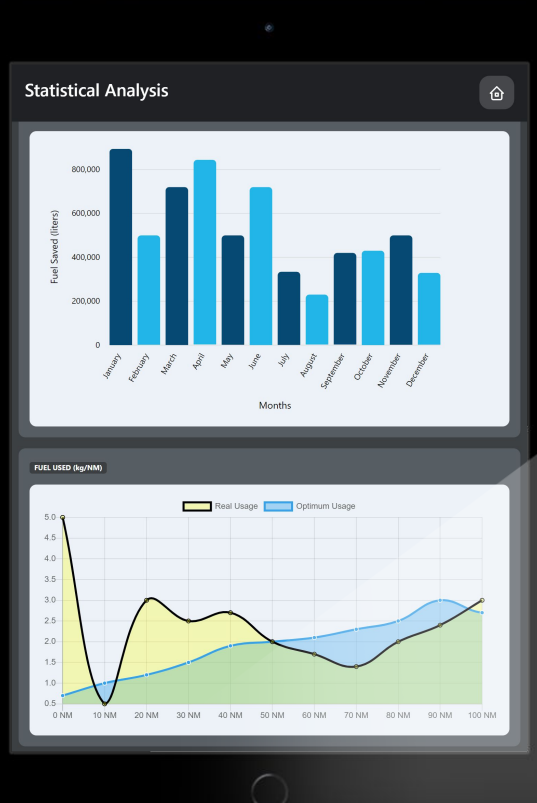Global Aviation Fuel Consumption Statistics
As explained by the International Energy Agency (IEA) , the energy consumption efficiencies met a crisis after the surging impacts of the COVID-19 Pandemic. The sluggish global progress after the effects of COVID-19 has intensified the need for urgent and better fuel conserving approaches because the recent upcoming years is a critical period for energy-based industries.
The historical (light blue area) and the forecasted (dark blue for 2019 forecast and green for 2020 forecast) statistics for global aviation fuel consumption between 2013 and 2021 were illustrated by a chart shared by the IEA group, as shown below.

| Year of Global Fuel Consumption | Historical or Predicted Statistics | Fuel Quantity (Litres/100 ATK) |
|---|---|---|
| 2013 | Historical | 24.4 |
| 2014 | Historical | 24.3 |
| 2015 | Historical | 23.8 |
| 2016 | Historical | 22.9 |
| 2017 | Historical | 23.0 |
| 2018 | Historical | 22.8 |
| 2019 | Historical | 22.4 |
| 2020 | Forecasted (2019 and 2020) | 22.1 |
| 2021 | Forecasted (2020) | 21.9 |
These statistics show that the fuel consumption of the Airline Industry keeps getting lower with every passing year, which provides an overview that airline companies keep innovating and finding methods to mitigate fuel consumption with innovative research, development, and engineering tactics. Another impact in lowering fuel consumption is the global effort in encouraging renewable energy in the Airline Industry. The impact of the COVID-19 pandemic also resulted in a decline in passenger and freight airline operations, which can also be a result of this declining behaviour. However, it is important to understand that the new-age trends and efforts collectively lead to a continuous decline of fuel consumption and better control over fuel via harnessing modern technologies.
What challenges are met by Airline Practitioners in upheaving resourceful fuel consumption efforts?
Eco-friendly Initiatives
Aviation players and many other entities and stakeholders in the Airline Ecosystem must take the issue of environmental and social responsibility very seriously. Airline companies require secure and well-tested CO2 Emissions reduction protocols. They must be responsible for tailoring efficient, diverse initiatives to regulate the environmental impact both on-air and on the ground. Also, it is very important to ensure that the fuel consumption propaganda is a green and eco-friendly effort to mitigate the threats imposed by hazardous fuel emissions. Therefore, airline corporations must be equipped with foolproof CO2 reduction and compensation initiatives that meet the demands of eco-friendly standards and introduce sustainable products and services for a greener tomorrow.
Fuel Efficiency Challenges
There are many instances that hinder the efficiency of fuel consumption in the corporate sector of this industry. Some of the main fuel efficiency challenges are:
- communication issues between pilots and other departments,
- data collection limitations,
- disparate data sources with no interoperability,
- lack of insight to identify lucrative fuel efficiency improvement potentials,
- the diversity of fleets in terms of fuel consumption behaviours and more.
In general, the main impact of isolating airline players in uncovering ways to gain the fullest fuel efficiency is technological limitations. When their core system solutions fail in identifying the actual pattern of airline spending and invest more time in collecting data rather than accurately analysing them, they become inefficient and laggard because they cannot optimise something that they cannot scientifically or statistically represent. Lacking data capitalising and predictive capacities in administering fuel consumption can inefficiently lead to many unfavourable results, like fuel starvation.
For example, a fuel starvation incident was recorded on the 27th of March 2016, the flight ATR 42-500 departed Esberj faced detrimental malfunctions due to fuel starvation in the left engine. This was a result of a faulty fuel quantity indication in the systems that led to hot section damage and in-service deterioration, which could have cost many lives. It was later reported that the following operational deficiencies were found:
- No proper procedures to manage fuel calculations
- Faulty fuel management variations were not isolated efficiently by the crew
- Faulty Fuel Quantity Indication System
- Failure in communications – they were not able to declare a MAYDAY to ATC
- Flight Crew Workload was high and stressful during malfunction occurrence
- Pilot’s inability to detect engine compressor issue due to the limitation of data and real-time visibilities
Read more about this incident by visiting here.
Other Technological Limitations
Fuel Data Analytics Inefficiencies
Technological limitation hinders the streamlining operational efforts initiated by airline players in controlling the fuel consumption of their fleets. One of the technological limitations that affect the fuel consumption efficiencies in the airline industry is their incapability in unlocking prompt, accurate and success-guaranteed fuel data analysis. Improper technological employment in measuring and monitoring fuel consumption can lead to the inability to reduce fuel consumption and wastages. It is difficult for these industrial practitioners to save time, money and fuel without having the needful data-driven insights and predictions on fuel consumption. With laggard and inefficient analytical capabilities, they will fail in providing insights to detect corresponding savings and fuel application trends and augment operations based on prescriptive and predictive revelations.
Lack of Interoperability
Another limitation is the lack of connectivity. When the core system of the airline practitioners has severed interconnection they will be in jeopardy. Having ineffective connections will disable them from interoperating with the existing sources and integrate raw data into the system network. These limitations result in laggy operational and decision-making efforts by the pilots and other key decision-makers responsible for controlling the fuel consumption of fleets. Seamless integration between systems, applications, web portals, cloud platforms and other entities in the IT Ecosystem is, therefore, a not-to-be-missed upgrade for Aviation Networks of the new age.
Communication Gaps
Thirdly, passive pilot engagement is one of the main technological limitations faced in the airline industry. The pilot is the key stakeholder in optimising the fuel efficiency programs in any airline. As much as the communication lines between the pilot and other aviation departments must be optimised, the customer support portals during and after technology solution implementation should also be active for better communication advantages. Thus, a user-defined and dedicated platform for pilots and the crew with cutting-edge communication capacities and crucial training is mandatory in this industry.
How New-Age Technology Benefits The Aviation Practitioners with Monumental Fuel Consumption Efficiencies?
As technology solution providers have made lives easier for many practitioners in many industrial domains, they have also made amazing contributions to make fuel savings too easy for the Airline Industry. Starting from flight planning, aircraft data transmission, data collection to statistical analysis, technology facilitates airline players across the vast Airline Industrial Domain. Modern Technology Tacklers enable solutions that give consolidated views of fuel consumption with real-time and predicted parametric readings. More importantly, these solutions are enhanced to intelligently prescribe ways to augment pilot actions to narrow the gap between acceptable and resourceful fuel parameters and actual parameters. Pilots are now empowered with the luxury of using a mobile device to tweak a digital twin to monitor the actual and desired parameters on air, like fuel consumption, thrust consumption, fuel density, fuel properties, the health of fuel tanks, spool speed, combustor temperature or many more.
Here are some of the noteworthy benefits that you can gain from technological solutions of the new age.
- Ability to make financial and investment plans for fuel spending in a resourceful manner
- Corporate spend saving and ecosystem preservation via reduced and efficient fuel consumption
- Dedicate to re-focusing operations with hi-speed and laggard-free internal communications and fuel program uptakes
- Exploit the power of modern technologies like Digital Twin, IIoT, AI, Predictive Analytics, Embedded Analytics, Prescriptive Analytics and more
- Harnessing an all-inclusive, scalable and intuitive fuel efficiency platform with highly-trained AI models and other hi-tech tools and modules
- Promote the communication abilities of pilots and other officials to collaboratively make lucrative fuel decisions
- Provide enough support and closure to optimise Flight Plans
- Tackling transparent fuel data to capture information to dispel dispensable expenses and augment fuel initiatives
- Wielding a shared and secured data system to demand data from any source and collect insights for saving potentials
How can Cerexio help?
Like always, Cerexio is capable of meeting all technological demands in any industrial domain. Legacy fuel consumption solutions are confined to a few services such as operational flight planning (with basic flight details), actual aircraft data transmissions in limited instances, data sourcing with excel-based output and use of historical data to predict additional fuel requirements on a monthly basis. But with Cerexio, you can take a lot more steps further! Cerexio airline-based technology solutions inherit predictive capabilities that illustrate user-based predictive projections in dynamic or even during seasonal variations. As our solution practitioners will collaborate with domain experts, we will initiate programs to explore new hidden parameters that affect the opportunistic fuel consumption of your fleets and develop a comprehensive curriculum to educate your crew members to make self-reliant decisions during dynamic events. To elaborate, Cerexio Airline Solution can invariably serve pilots and other key stakeholders in scenarios such as dynamic traffic density fluctuations, unprecedented asset failure, or an unheard-of rapid climate change.
So how does Cerexio optimise the fuel consumption of airline players with modern technologies? Cerexio has the propensity to ideally save fuel consumption up to 4%, which is a massive optimisation in the Airline Industry for it has a multiplicative advantage- when 4% fuel consumption optimisation is added in all fleets. To achieve this advantage, Cerexio Solution is equipped with a range of modern technological features that give insights to manoeuvre contingency fuels, optimise ground operations and minimise turbulence. It is important to note that all features in our airline-based solution can be brought to the fingertips of the users via a cloud-driven or on-prem dashboard, web application or tablet application based on the convenience of the target users. The signature features of Cerexio’s Fuel Efficiency Platform are explained below.
AI-powered Models
Immediate Data Moving and Exploring Capabilities
Pilot and Crew Engagement Tools

Predictive and Prescriptive Analytics
The modern prescriptive analytics capabilities of the Cerexio Solution have made it to be the unchallenged solution in the Airline Industry’s Software Solution Market. This solution uses attractive graphical representations to illustrate prescriptive measures that can be taken by the pilot to save aviation fuel based on current scenarios. This technology can recommend optimal flight plans and fuel usage methods to help pilots make fuel-saving decisions based on real-world scenarios.
The predictive technology inherited by this solution will efficiently illustrate turbulence possibility levels, altitude fuel fluctuations, CO2 emissions, and individual fleet fuel checks for the next 7 days! This technology also allows advanced route observation capabilities powered by past and present data to predict the most optimal maps to meet all service demands while saving fuel simultaneously. These capabilities make sure that your flight controlling and maneuvering efforts are aligned with robust fuel-saving tactics.
Conclusion
The Airline Industry faces many disruptions and challenges with every passing minute, but the inability to control and save aviation fuel consumption can lead to major financial and operational drawbacks that aviation practitioners and industrial giants in the airline industry should not meet. As Cerexio has developed an advanced and technologically bold approach to control this limitation, airline companies can exploit fuel-oriented data and gain a range of capabilities that contributes to elevating fuel consumption rates upto 4%. Your company can gain these advantages or learn more about this out-of-the-box airline fuel-saving upgrade by mailing us your concerns to info@cerexio.com or by connecting with our team via +(65) 6762 9293. Join us to transcend to the next stage of fuel consumption optimisation with a solution powered by the best and latest technologies in the industrial world!





